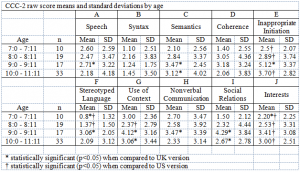Lisa Christensen, Maggie Hansen, and Bethany Hillary with Dr. Martin Fujiki, Communication Disorders
In the field of speech-language pathology, we encounter many children with what is known as language impairment. This impairment cannot be attributed to intellectual or sensory factors, and has been shown to involve a delay in both semantic (word meanings) and syntactic (grammar and structure) abilities. Some researchers also question whether pragmatic abilities (language usage in real-life contexts) are affected in those with language impairment. However, an instrument to evaluate pragmatics is very difficult to design. Typical formal tests don’t allow for varied contexts—an integral part of pragmatic skills. Eliminating these varied contexts inherently reduces the validity of results.1
The Children’s Communication Checklist 2 (CCC-2) is a new instrument designed to measure pragmatic behaviors of children. It relies on the observations of those who know the child best, rather than the test administrator’s perception of the child’s pragmatic skills. Parents or teachers of a child who know his/her pragmatic behaviors well can fill out a checklist, and their responses yield accurate results about the child’s level of pragmatic language functioning.
When we first began this research we noticed a problem with the CCC-2: all the normative data for the CCC-2 was gathered in the United Kingdom, which may have different pragmatic expectations and norms. Knowing of the importance of local norms, we designed a plan to attain normative data for the local area by having Utah County teachers complete the checklist for their classes. This would be helpful to future clinicians and researchers who wish to use local norms in conjunction with the CCC-2 for more accurate results.
Soon after we began our research, it came to our attention that an American version of the CCC was in the process of being published, thus putting the significance of our research goal in question. However, Dr. Fujiki reminded us that local norms are always valuable, and that they might reveal unique differences about our specific area. Consequently we planned to compare our local norms with both the UK and the US versions of the CCC-2.
As we began the process of establishing local norms, we realized that although we had access to the UK and US norms, we didn’t know exactly how those norms were obtained. With Dr. Fujiki’s help, we were able to follow standard statistical procedures to obtain viable norms.
After the statistics were run and our new data was compared with the published data, we were surprised at the ensuing differences. At the beginning of our research we had expected to see a significant difference between UK norms and our norms from Alpine School District. We also expected to see more similarities between the US norms and our own. However, we found that our data varied significantly from both sets of norms in separate subcategories, and we had an entirely new set of data on our hands. We also hadn’t imagined that the consistency between our norms and published norms would differ according to age group. But our results showed a large variance from the fourth grade age group while showing a small variance from the second grade age group.
In addition to the work we have done with the norms, Lisa has found this data to be valuable for yet another purpose—her graduate thesis. By doing multiple regression analyses with subscale scores from the CCC-2 and Teacher Behavior Rating Scale, she will look for correlations between pragmatic language abilities and the subtypes of withdrawal and sociability. She has already been working with Dr. Fujiki to write a prospectus and will be meeting with the rest of her committee before fall semester, after which she will begin analysis on the data. This ORCA project helped give her experience as well as data that contributed greatly to her graduate thesis.
If we were to continue with this research, several things would make it more applicable. First, it would be helpful to include more subjects—ideally the same number used in the published norms to make our results and the comparison between our results and the published results more valid. Also, we would want to determine what makes the difference between the published UK and US norms. Has a different form of the test been used, or were the same test questions administered to obtain the different norms? Would a two sample t-test indicate a significant difference between the published norms from the UK and the US? If a significant difference were to be discovered, it might merit more in-depth research.
The most important thing yet to be done with this data is to translate it into a usable format for local clinicians and graduate students who will use the CCC-2. The research has been interesting, but the most fulfilling part would be to see the data put to good use.

References
- Fujiki, M. & Brinton, B. (In Press). Pragmatics and Language Impairment. Handbook of Child Language Disorders.
